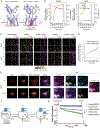Human STING is a proton channel
- PMID: 37535724
- PMCID: PMC11260435
- DOI: 10.1126/science.adf8974
Human STING is a proton channel
Abstract
Proton leakage from organelles is a common signal for noncanonical light chain 3B (LC3B) lipidation and inflammasome activation, processes induced upon stimulator of interferon genes (STING) activation. On the basis of structural analysis, we hypothesized that human STING is a proton channel. Indeed, we found that STING activation induced a pH increase in the Golgi and that STING reconstituted in liposomes enabled transmembrane proton transport. Compound 53 (C53), a STING agonist that binds the putative channel interface, blocked STING-induced proton flux in the Golgi and in liposomes. STING-induced LC3B lipidation and inflammasome activation were also inhibited by C53, suggesting that STING's channel activity is critical for these two processes. Thus, STING's interferon-induction function can be decoupled from its roles in LC3B lipidation and inflammasome activation.
Figures




Comment in
-
STINGing through the membrane to channel protons.Nat Rev Mol Cell Biol. 2023 Oct;24(10):689. doi: 10.1038/s41580-023-00658-z. Nat Rev Mol Cell Biol. 2023. PMID: 37644098 No abstract available.
-
Activated STING: an ion channel to trigger non-interferon-related functions.Signal Transduct Target Ther. 2023 Oct 16;8(1):388. doi: 10.1038/s41392-023-01633-y. Signal Transduct Target Ther. 2023. PMID: 37840036 Free PMC article. No abstract available.
References
MeSH terms
Substances
Grants and funding
LinkOut - more resources
Full Text Sources
Other Literature Sources
Molecular Biology Databases
Research Materials

